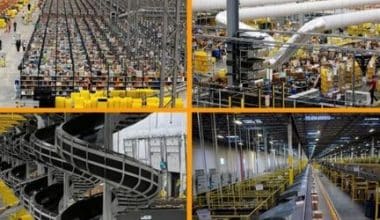In today’s world, the majority of shoppers find it less stressful to buy their products online. This, over the years, has contributed immensely to the explosion and popularity of e-commerce markets. Basically, you can order any goods online and have them delivered to your location without moving a muscle. As a result, most businesses can satisfy customers’ desire for quick pleasure, increasing the likelihood of a repeat purchase. Customers’ needs are being met by combining brick-and-mortar shops with Internet storefronts.
But then, two noteworthy e-commerce behemoths have dominated the e-commerce market majorly through their online presence. Of course, we’re referring to Amazon (AMZN) and Alibaba (BABA). While these two platforms are both e-commerce businesses, their business methods are vastly different.
For example, Amazon dominates both new and used product sales, while Alibaba serves as a sort of middleman between buyers and sellers. So, how does Amazon and Alibaba (Amazon vs Alibaba) stack up against each other?
Amazon vs Alibaba: Overview
To a large extent, Amazon and Alibaba are always in a constant struggle for the title of global eCommerce market leader. Amazon established itself as an online bookshop in 1995, while Alibaba launched its business in 1999, roughly five years after Amazon.
Now that both businesses have a strong brand presence in their home regions, there is fierce competition between these two tech behemoths as they seek new markets to expand into.
Alibaba has risen to become one of the world’s largest and most valuable eCommerce enterprises, with an IPO value of $21.8 billion at the end of 2014. Alibaba actually outperformed Amazon and eBay on the first day of trade.
Several similarities exist between these two eCommerce giants. For the most part, electronic products and merchandise, as well as digital media content, provide for a significant amount of Amazon’s revenue (including Amazon Prime, an annual fee-based subscription that streams video content, and other trending digital services).
Alibaba, on the other hand, has a multitude of eCommerce platforms focused on various types of vendors. Alibaba’s Taobao is one of the most profitable marketplaces in the Alibaba group, accounting for more than 80% of all sales. Plus even though their business models appear to be comparable at first glance, they are very distinct.
Alibaba does not engage in direct sales and, unlike Amazon, does not own any warehouses. They just assist small enterprises and well-known brands in reaching out to consumers. Amazon uses a managed online platform that mimics a traditional store but is always available.
Amazon vs Alibaba: Definitions
Beyond an overview or the fact that both Amazon and Alibaba are e-commerce platforms, you may want to find out a little about their backgrounds.
What exactly is Amazon?
Amazon, which was founded by Jedd Bezos in 1994, is the world’s largest e-commerce and cloud computing company, followed by Facebook, Google, and Apple. The corporation operates country-specific retail websites and ships products to other countries. Amazon’s business model is built up in such a way that;
- The business sells products directly to customers.
- Producers list their product on the site and pay Amazon a fee to use the service.
- Customers who have an amazon prime account pay an annual fee and receive not only same-day or two-day shipping, but also a subscription service that allows them to stream media products such as music and movies.
What exactly is Alibaba?
Alibaba, founded in 1999 by Jack Ma, is the world’s largest retailer and one of the world’s largest online business platforms, having operations in over 200 countries. It offers services to B2C businesses as well as B2B. Alibaba’s main commercial activity is e-commerce, but it also offers other services such as mobile commerce, online money transfers, and online auction hosting.
Through its wide web channels, it functions as a mediator between customers and producers.
Its business concept is built up in such a way that;
- Taobao, Alibaba’s largest site, is a fee-free marketplace. However, in order to generate revenues from advertising, sellers on this site pay for a higher search engine ranking.
- Tmall generates revenue by allowing large retailers to sell their products and pay annual fees, deposits, and commissions based on the sales made.
- Alipay, for example, is a financial instrument that protects customers against fraudulent transactions.
- It also makes money through its recently created microlending platform.
Amazon’s and Alibaba’s Background
After quitting his job as a VP at a Wall Street business in the mid-90s, Jeff Bezos launched Amazon. Despite its beginnings as an online bookstore, Amazon has evolved into the eCommerce behemoth it is today.
With the acquisitions of Twitch, Whole Foods, and over 40 other subsidiaries, the online retailer has branched out into every category imaginable. Amazon is also the largest online retailer in North America, with a market capitalization of $1 trillion.
Jack Ma created Alibaba, a China-based marketplace that connects Chinese factories with Western enterprises, five years later.
Unlike Jeff Bezos, Alibaba’s founder had no prior experience in technology or business. Jack Ma, in fact, was an English instructor who had previously failed in two business attempts.
Despite his early business failures, Jack Ma persevered and eventually founded Alibaba.com with the help of family and friends. After three years, his company became profitable, and it is now the world’s largest eCommerce company, with a market capitalization of over $800 billion.
Philosophical Disparities In the battle between Alibaba vs Amazon
Basically, Amazon’s business strategy is to become the world’s most customer-centric organization. If you’ve ever used Amazon to buy or sell something, you know that the customer is always right.
Even if the buyer is at fault, refunds are often available. They also provide over 214.8 million monthly users with competitive prices, delivery times, and customer service.
Amazon is truly customer-centric, offering the best possible prices at the expense of vendors and content partners.
But then, in reality, Amazon has been known to manufacture their own private label goods in order to increase market dominance by undercutting their own 3rd party merchants.
Meanwhile, Alibaba follows a different strategy, focusing on assisting small firms in their growth.
Here’s a quote from the Alibaba Group CEO, Daniel Zhang reaffirming his company’s main priorities in a recent report:
“As the world’s largest ecommerce platform, Alibaba’s principal commercial objective in the United States is to assist American brands, retailers, small businesses, and farmers in selling to customers and trade partners in China, as well as other key global markets.”
Like we earlier mentioned, Alibaba’s largest site, Taobao, does not charge its merchants or customers to complete transactions, which goes a long way to reflect the company’s goals. Rather, Taobao makes money by charging vendors to rank higher on the site’s own search engine.
Alibaba is, in many ways, the polar opposite of Amazon. They are far more focused on the seller, whereas Amazon is entirely focused on the client.
Amazon vs Alibaba: Differences and Similarities
Asides from philosophical disparities bee are major differences and similarities between the two just in case you’re still in confusion.
Differences in Business Models Between Alibaba vs Amazon
On the surface, Alibaba’s revenue stream appears to be a mystery.
Most people consider Alibaba to be little more than a directory of Chinese suppliers with no direct-to-consumer eCommerce capabilities. Alibaba, on the other hand, has a number of companies that provide the majority of their revenue.
To begin, the primary distinction between Alibaba and Amazon is that Alibaba is essentially an intermediary between corporations and Chinese suppliers. Furthermore, Alibaba does not have control over the inventories.
Amazon, on the other hand, has its own inventory and supply chain, and it sells its own products directly to customers. As a result, Amazon frequently competes with merchants that attempt to sell things on the Amazon website.
Furthermore, Alibaba operates through a variety of firms, including Alibaba, Aliexpress, Taobao, and Taobao Mall (TMall).
But then, while most people think of Alibaba as a B2B marketplace, its core operation is similar to that of eBay or Amazon. In fact, Alibaba’s revenue comes primarily from domestic eCommerce, accounting for 65 percent of overall sales.
Read Also: Amazon Affiliate Marketing: All You should Know and How to Earn
Alibaba’s several websites facilitate B2C and C2C transactions:
Its flagship website, Taobao.com, offers a fee-free marketplace for vendors and shoppers. The platform allows both consumer-to-consumer and business-to-consumer transactions. As a result, small enterprises and individuals can use the site to build online stores.
On the other hand, Aliexpress is comparable to Taobao, except that it caters to a global audience. Unlike Taobao, which is entirely in Chinese and only serves Chinese customers, AliExpress accepts orders from anyone in the world. The AliExpress website is available in 16 languages and covers the majority of countries.
Additionally, Taobao Mall (TMall) is an online platform specializing in major brands like Nike, Apple, and Gap. The platform is more akin to Amazon, where large corporations and brands may sell directly to customers.
So in general, Alibaba.com is an Asian supplier directory and marketplace. They make money by charging sellers to have a storefront on their website and charging commissions on transactions.
- Sellers, deposits, annual user fees, and sales commissions from merchants are the main sources of revenue for Alibaba.
- Aside from ecommerce, Alibaba takes a percentage of every sale made through Alipay, a third-party online payment platform with over 1.2 billion users across the world.
- To give you an indication of Alibaba’s size, in 2019, Alibaba accounted for about 80% of all online retail sales in China!
- In reality, in terms of ecommerce market share in their native country, Alibaba vastly beats Amazon. In comparison, Amazon only has a 50%+ market share of US online sales.
The Business Model of Amazon
Amazon’s business model has a lot more moving pieces than Alibaba’s, including direct sales, partner merchants, subscriptions, web services, and so on.
To begin with, Amazon’s online store sells goods directly to customers and stores a large portion of their own inventory. While Amazon sells some of its own private label products, third-party merchants account for more than half of Amazon’s marketplace revenue.
The key difference between Alibaba and Amazon is that Amazon stores and fulfills its own products and maintains a massive network of warehouses where inventory is kept.
The Amazon website attracts customers because it provides incredibly rapid shipping times and the lowest rates available online.
As previously stated, Amazon generates the majority of its eCommerce revenue by operating as a marketplace for other shops. Third-party Amazon sellers, on the other hand, do not have to pay a fee to advertise products on the website.
Instead, Amazon charges a fee for each successful transaction. Sellers must also pay to have their products advertised on the Amazon website.
Amazon Prime, in addition to product sales, is a source of revenue for the company. Customers can obtain free two-day or same-day shipping on certain purchases, as well as access to Amazon’s movie and music streaming services, for a yearly subscription.
In the United States, Amazon Prime has shown constant growth, with an estimated 112 million subscribers as of December 2019.
Aside from shopping, Amazon provides a broad set of web services that fuel a large portion of the internet today.
Alibaba vs Amazon: How They Make Money
Another distinction between Amazon and Alibaba is how they charge their customers.
To put things in perspective, Amazon makes money by charging fees to both shoppers and merchants. Third-party sellers on Amazon must pay a percentage of income as well as Amazon advertising fees and other miscellaneous costs for completed purchases.
Meanwhile, customers are driven to join Amazon Prime, which provides them with two-day or same-day shipping as well as a slew of additional benefits.
Alibaba, on the other hand, charges a fraction of the fees that Amazon does. For example, selling on the Taobao marketplace is completely free, and neither the vendor nor the buyer pays any service or final value costs.
To acquire visibility for your products on Taobao’s internal search engine, you must pay to rank higher.
To be successful on Amazon, however, retailers must pay both a percentage of their sales and Amazon advertising costs.
Alibaba vs Amazon: Which Company Moves More Merchandise?
Both platforms will be compared based on GMV to provide a clear comparison of Alibaba vs Amazon in terms of pure eCommerce volume.
The value of sales or placed orders is referred to as GMV (gross merchandise volume), not the company’s actual revenues or profits.
A $100 purchase of a coffee maker on Alibaba, for example, will account for $100 of Alibaba’s GMV. However, just a little portion of that sum, say $2, will be included in the company’s real earnings.
GMV provides additional insight into a company’s performance when determining which company moves the most product. The figures are as follows.
Alibaba's gross merchandise value (GMV) for fiscal year 2020 was $1 trillion.
According to Marketplace Pulse, based on Amazon’s reported numbers, the Amazon marketplace produced a total GMV of $335 billion in 2019.
According to the data above, Amazon’s numbers are substantially lower than Alibaba’s, and they aren’t even close. Alibaba easily moves more merchandise than Amazon, demonstrating the enormous size of the Chinese market!
Amazon vs Alibaba: Which Company Generates More Revenue?
Alibaba made $22.22 billion in revenue in the second quarter of 2020. During the same time frame, Amazon’s revenue was $88.91 billion.
Despite the revenue discrepancy, many predict that Alibaba will catch up to Amazon in the next few years. Alibaba, in fact, has maintained high growth rates year after year.
According to reports, Alibaba’s annual sales climbed by 40.74 percent from 2018 to $56.152 billion in 2019.
And in 2017, its revenue climbed by 73.51 percent to $39.898 billion in 2018.
On the other hand, here are Amazon’s annual revenue growth rates in comparison.
- Amazon’s yearly revenue in 2019 climbed by 20.45% from the previous year, reaching $280.522 billion.
- Amazon’s annual income climbed by 30.93 percent from 2017 to $232.887 billion in 2018.
As you can see from the report, Amazon’s growth is substantially slower than Alibaba’s, and Alibaba will eventually catch up to Amazon if it continues on its current path.
Alibaba vs Amazon: Which Company Has More Expansion Potential?
Alibaba makes the majority of its money from Chinese online sales. In contrast to Alibaba, Amazon produces a much bigger share of its revenue from outside the United States.
Here’s how Alibaba and Amazon’s revenue is distributed geographically:
- The overseas ecommerce sales of Alibaba Group accounted for barely 5% of the company’s total revenue.
- Alibaba’s revenue came from internet retail sales in China, which accounted for 66% of its total revenue.
- International income channels accounted for roughly 27% of Amazon’s total sales.
According to the data above, Amazon has a significantly better track record when it comes to overseas sales. However, if you look at the figures from a different angle, Alibaba’s worldwide expansion potential is limitless.
Alibaba just launched new platform features that assist US vendors and is significantly investing in international expansion.
And despite the fact that many significant brands are avoiding Amazon owing to counterfeit issues, Alibaba’s TMall has grown by more than 40% year over year.
Alibaba vs Amazon: Which Company Is More Profitable?
Alibaba moves more products, but Amazon makes more money on each sale.
However, when it comes to determining which firm produces the most money, Alibaba comes out on top.
Alibaba made a net profit of $13.1 billion in 2019, according to Forbes. In the same year, Amazon had a net profit of $11.6 billion.
Alibaba also had a profit margin of 23.3 percent, which was much greater than Amazon’s 4.1 percent profit margin.
What Causes Such a Large Profit Gap?
The vast margin disparity between Alibaba and Amazon can be summed up in one word: infrastructure.
Amazon stocks its own products and invests heavily in warehouse and delivery infrastructure in order to dominate the online business.
This means that Amazon has to deal with not just the complicated logistics of establishing and operating a warehouse network, but they are also attempting to build a shipping company to compete with FedEx and UPS at the same time.
Alibaba, on the other hand, has a much lower overhead. Remember that Alibaba does not sell its own products; it only facilitates eCommerce transactions.
And, despite being the world’s largest eCommerce company, Alibaba operates more like a software corporation than an eCommerce merchant.
Amazon’s business strategy necessitates a considerable amount of capital to grow, but their expenditures have created such a high entry barrier that competing with them in the long term will be nearly impossible.
Alibaba, on the other hand, has been able to achieve rapid and continuous development because to its hands-off approach. Alibaba’s low-cost business methodology enables them to generate much better profit margins and more scalable expansion.
In the end, it will be interesting to see which company’s business model will win out.
Similarities between Alibaba vs Amazon
Despite their philosophical differences, Alibaba and Amazon have a few things in common.
Both corporations, for example, have few competitors and are market leaders in their respective home countries.
In the year 2019,…
TMall, Pinduoduo, and JD.com, all owned by Alibaba, accounted for 80% of all online retail sales in China.
Amazon now has a market share of more than 50% in the US eCommerce market, surpassing eBay (6.6%), Apple (3.9%), and Walmart (3.7%) combined.
Alibaba and Amazon, in addition to dominating eCommerce, have their own payment systems:
- Alipay, Alibaba’s mobile and internet payment system, has over 700 million active users per year.
- Amazon Pay is a payment service that allows Amazon customers to use their Amazon accounts to make purchases on non-Amazon websites.
Is Alibaba Worth More Than Amazon?
When it comes to generating revenue, Amazon is unrivaled. In fact, Amazon’s revenue in the second quarter of 2020 was $88.91 billion, compared to $22.22 billion for Alibaba.
Who Is Better Amazon or Alibaba?
Amazon’s stock has performed better than Alibaba’s, with a 38 percent gain over the past year compared to Alibaba’s 13 percent gain.
Whats Bigger Alibaba or Amazon?
Amazon made 232 billion dollars in sales last year, up roughly 31% from the previous year. Alibaba’s annual revenue of 39.9 billion US dollars may appear small in comparison, but it is the only company that might compete with Amazon in the coming years.
Is Alibaba Good Quality?
Alibaba, like many other eCommerce platforms, has a large number of respectable and trustworthy merchants. Trade Assurance, a supplier verification service, is also available to protect your payments made through the Alibaba.com payment platform. So the question of if Alibaba is of good quality shouldn’t be on the table.






